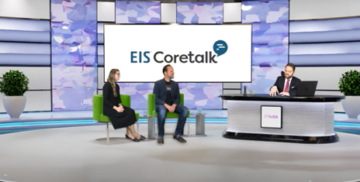What do you get when you add together four people who are deeply passionate about helping companies transform, Bruce Buffer (the UFC announcer), a giant hamster wheel, and video editing? An extremely entertaining debate on digital transformation strategy aka the most recent episode of EIS’ CoreTalk.
EIS Coretalk Episode 5: People or Technology: What Drives Digital Transformation in Insurance?
Watch the episode – I promise Bruce Buffer and the Hamster Wheel will make sense in context. Tony Grosso and I debate the best path for Digital Transformation, and we share suggestions on how to build a strategy for success. Plus, you’ll have a good chuckle!
I would say that there is DEFINITELY a wrong way to build your digital transformation strategy, but the jury is still out on the one ‘right’ way to build your strategy. There are best practices that should be a part of your plan, but your specific journey will be unique.
Read on to hear our 3 points of debate and help inform your own strategy.
The Great Debate – 3 Areas of Digital Transformation Strategy
1. People or Technology Focused?
🧍🏻♀️🧍🏻♂️ The Case for People Focus: My stance: Successful transformations start with people. Digital Transformation sounds like it’s about technology because of that word digital, but at the center of every technology solution there are people. People developing the tool, people interacting with the tool to do their job, people whose customer experience hinges on the technology working.
People are vital players in every step of a digital transformation. Even the most elegantly designed technology won’t work if the person engaging with it lacks the skills, knowledge, or willingness to adopt it.
You also must have a change management plan that complements your technology implementation to see a sustained transformation that provides the desired ROI.
Want to learn more about people-driven digital transformation? Check out this video for three key Change Leadership strategies.
💻 The Case for Technology Focus: Tony’s stance: Transformation is all about the people, until it’s not about the people. In other words, digital transformation is all about the technology.
For example, an insurance carrier has talked about transformation for several years and has yet to pull the trigger. Overwhelmed from trying to grow their business with legacy technology, they focused on making updates to their old technology. 18 months later, they found themselves out of date again. Automating these tasks with new technology, on the other hand, would’ve solved their problem with technology-enabled scalability
2. Big Bang or Incremental Change?
💥The Case for Big Bang Approach: Tony advocated for a Big Bang. If there is no ability to stretch your legacy systems any further, a “greenfield” approach can be a great path to transformation. A Greenfield Technology Platform allows you to start with a blank slate and allows you to build a new offering that integrates with the legacy system functionality. For more on a greenfield transformation approach check out this blog post from Tony’s team at EIS.
👣The Case for Incremental Change: I suggest starting with a big vision, then breaking it down to realistic and manageable stages. This gives you the opportunity to fix your most pressing issues first, work out the kinks in your approach to transformation, and allow your team to see the benefits that come along with the larger vision.
In an ideal world, legacy technology wouldn’t have an impact on our plans, budget, and timeline, but in the real world, they do. Not every company can do a complete lift and shift from old technology to a new platform.
For an enterprise-wide, massive, big bang approach to work, you need to have a crystal clear vision, a ton of resources that are solely focused on the initiative, and a humungous budget.
Bite off more than you can chew and you’ll likely miss out on a ton of incremental benefits because the project is taking too long.
The incremental approach allows your team to see the results sooner and give you the opportunity to celebrate your wins. In the debate, I was very rudely cut off, but celebrating these incremental benefits will drive demand for transformation across your organization. Suddenly, you will start to hear things like, “The Claims Team’s implementation went live and they love the solution so much. I can’t wait until it’s our turn!”
Positive momentum builds on itself and it helps to change your culture. Incremental value builds on itself too. Maybe you can start to use the savings you recognize in one area to fund other transformation projects to further your momentum.
3. Tried-and-True Technologies or Cutting Edge?
🤝🏻 The Case for Tried-and-True Technologies: I believe there will always be nice, new, and shiny technology to distract you. But it’s not always critical to have the latest and greatest to drive your desired outcome.
Not every organization is ready to jump head first into the deep end of AI and emerging technologies, and that’s okay! Frankly, I think many businesses lack the prerequisites to do just that.
I love working with customers who are ready and willing to try out our new solutions, and you can do some really cool things with intelligent automation.
But I also love helping customers make a big leap in efficiency using time tested tools, like Workflow, to take them to the next level.
Progress is progress! We should be driving toward outcomes, not a specific type of technology use.
Find a partner who will help you understand what is possible and who will help you stay on top of trends, while also having enough experience in the industry to understand the other dynamics that come along with a transformation. Find a partner that has a time tested approach to supporting process improvement, change management, and has a wide breath of capabilities available in their solution suite.
🔮 The Case for Cutting Edge Technologies: Tony’s suggestion? Go big or go home.
He argues that the “tried-and-true” approach only perpetuates the sea of sameness. If you want to stand out, you should do something that others are not.
With changing customer expectations, will tried-and-true technologies meet the cut? His suggestion is to think beyond what we know from the last few years and work to envision a different type of business process.
Subscribe to the Naviant YouTube Channel
To catch more Question Corners, plus OnBase training webinars and other video content, subscribe to the Naviant YouTube channel.
Want More Content Like This?
Subscribe to the Naviant Blog. Each Thursday, we’ll send you a recap of our latest info-packed blog so you can be among the first to access the latest trends and expert tips on workflow, intelligent automation, the cloud, and more.




